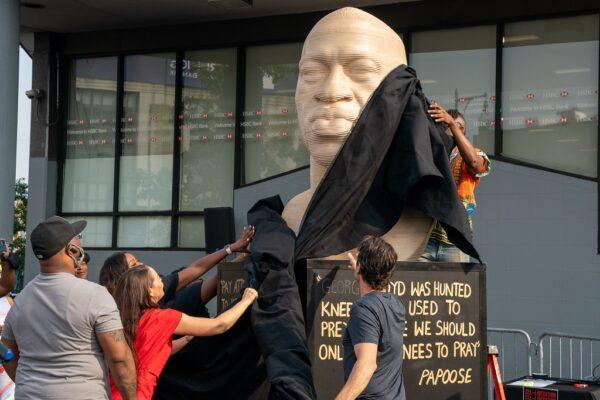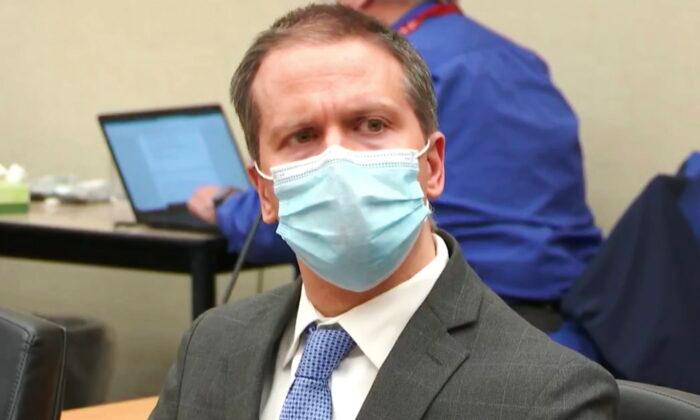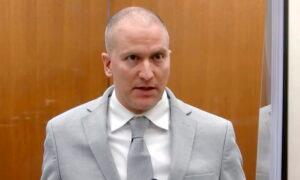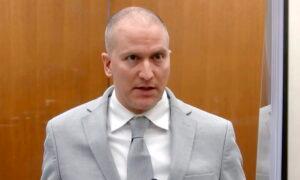The narrative surrounding the 2020 death of George Floyd in Minneapolis provoked a wrath that led to summer riots costing billions of dollars in damage and influencing policy decisions in government, business, and education.
But what if that narrative isn’t true?
“Here’s what you weren’t allowed to see,” Ms. Collin told The Epoch Times. “Question why you were not. It’s pretty clear none of this had to happen if you look at how this was orchestrated.”
Ms. Collin interviewed several retired Minneapolis police officers who were present at the riots, as well as imprisoned former officers Derek Chauvin and Alex Kueng.
The documentary—based on Ms. Collin’s book “They’re Lying: The Media, The Left, and the Death of George Floyd”—addresses multiple key facts that mainstream media left out of the narrative, in addition to evidence Judge Peter Cahill refused to allow in Mr. Chauvin’s trial.
“I think this was manipulated from the beginning, especially the way the media capitalized on a very divisive message while ignoring the fact that the arresting police officer in this case—Alex Kueng—is black, and that there was nothing to support Chauvin being a racist,” Ms. Collin said.
The documentary allows those involved to tell another story, even providing a literal new angle in that of the body camera footage that shows Mr. Chauvin’s knee on Mr. Floyd’s shoulder, differing from the viral cellphone video which appeared to show the officer’s knee on his neck.
But before it even goes there, the documentary addresses Mr. Floyd’s multiple arrests, aliases, and the drugs such as methamphetamine and fentanyl that were in his system the day he was detained by Mr. Kueng for the charge of forgery.
Body camera footage shows he was resisting arrest and refused to remain in the back of the police car. Officers also found pills containing methamphetamine and fentanyl in the back of the police car that were positive for Mr. Floyd’s saliva and DNA, the film says, suggesting he was trying to eat them to avoid being charged with possession.
He told the officer he had just lost his mother, who in fact died in 2018, and that he had been shot in a previous arrest, which also wasn’t true.
In addition, he told the officers that he wasn’t “on anything.”
Long before Mr. Chauvin arrived and used the department-approved maximum restraint technique (MRT) captured on a phone camera, Mr. Floyd was saying he couldn’t breathe.
‘In the Middle of a War Zone’
According to former officer Scott Creighton, what took place following the incident was like a war, while the media called it “peaceful protests.”The officers were denied a request for riot gear, former officer Lindsay Herron said.
“And we were in the middle of a war zone,” she said.
Officers were ordered to not respond to rioters, they reported in the documentary.
Former officer Jason Reimer said it was like being “in a third-world country.”
“This is the thing that bothered me about government officials is they sat back and let people throw rocks and bricks and firebombs and we’re supposed to just put on a helmet and take that,” he said, later adding that the tactical decision was “politically driven.”
“They were going to use this for a political narrative, and they did,” he said.
Former Minneapolis Police Chief Medaria Arradondo ordered the department to abandon the precinct, which opened it up to being demolished by rioters.
“It was like a zombie movie,” former officer Al Williams said.

‘Fatal Level of Fentanyl’
Meanwhile, in the autopsy conducted 12 hours after Mr. Floyd’s death, Hennepin County medical examiner Dr. Andrew Baker reported that there was no medical indication of asphyxia or strangulation and that Mr. Floyd, in addition to having “a fatal level of fentanyl under normal conditions,” had preexisting health conditions such as a 75 percent blocked artery and coronary artery disease.The attorney for Mr. Floyd’s family, Ben Crump, had an independent autopsy report conducted without the use of the physical body. The report concluded that the 46-year-old Floyd, “was a healthy young man,” with no “underlying medical problem that caused or contributed to his death.”
Dr. Baker’s initial autopsy report shows no bruising on Mr. Floyd’s neck, and stated that “if he were found dead at home alone and with no other apparent causes, this could be acceptable to call an OD,” the documentary reported.
The documentary questions why the FBI met with Dr. Baker and what became of that meeting, a meeting which bothered one physician.
Dr. Tom Haney said when he discovered that the FBI got involved within 12 hours, “that raised a red flag for me.”
“I think that there are a lot of questions that remain unanswered with this,” he said.
Minnesota Attorney General Keith Ellison filed charges against Mr. Chauvin and Mr. Kueng, as well as former officers Thomas Lane and Tou Thao.
During Mr. Chauvin’s trial, evidence was presented that showed a miscommunication between the fire department and EMS which resulted in a delay in response time.
Mr. Arradondo admitted in court that it did appear from Mr. Chauvin’s body camera that his knee was on Mr. Floyd’s shoulder blade when using the restraining technique.
Mr. Arradondo and Officer Katie Blackwell both denied in court that this was a department-approved method.
“I don’t know what kind of improvised position that is so it’s not what we trained for,” Ms. Blackwell said.
However, each former officer interviewed said they were trained in MRT and that the department’s official manual gave instructions for MRT.
“It’s tough to hear people lie, just straight lie,” Ms. Herron said.
However, Judge Cahill didn’t allow for the image of the MRT training to be shown in court.
In addition to this, he refused to allow for evidence of the miscommunication between the fire department and Mr. Floyd’s previous drug arrests to be presented in court.
‘The Kind of Case That Ends Careers’
Ms. Collin’s previous report on a court deposition and retaliation case in Hennepin County showed the pressure county attorneys faced to charge the officers involved.The conversations surfaced in former Assistant County Attorney Amy Sweasy’s sex discrimination complaint filed in 2022 in Hennepin County against County Attorney Mike Freeman.
In her deposition, she discusses how her work environment had changed after she approached Mr. Freeman and said she wasn’t comfortable with charging the officers.
“In fact, she said that she didn’t want to be a part of it and she withdrew from the case along with one of her colleagues,” Ms. Collin said. “They said ethically they couldn’t support charging the officers.”
“He called me later in the day on that Tuesday and he told me that there were no medical findings that showed any injury to the vital structures of Mr. Floyd’s neck. There were no medical indications of asphyxia or strangulation,” Ms. Sweasy said. “He said to me, ‘Amy, what happens when the actual evidence doesn’t match up with the public narrative that everyone’s already decided on?’ And then he said, ‘This is the kind of case that ends careers.’”
It will be difficult to unwrite a script that was written before the trial even began, Ms. Collin said.
On Nov. 20, the U.S. Supreme Court refused to hear Mr. Chauvin’s appeal with no explanation.
“This wasn’t unexpected,” Ms. Collin said.

‘People Are Tired of Being Lied to’
The case is ridden with injustices and lies, she said, but she still is holding out for truth.In its wake, police departments across the country were either defunded or left unsupported.
Officers quit in droves, while many who served during the riots were left with post-traumatic stress disorder.
“I think we all have power in supporting our local police departments,” Ms. Collin said. “These men and women don’t get enough credit for what they go through to serve and protect every day. As the wife of a former Minneapolis police officer, this hits home for me.”
It’s time for the silent majority to push back against the lunacy of a narrative that isn’t supported by facts, she said.
“I think people are tired of being lied to, but at the end of the day, we have to push forward and continue to stand up, not only for ourselves but for the truth of the situation,” she said.







